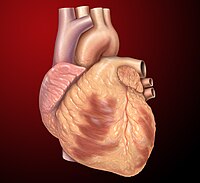
Photo from wikipedia
Wild-type transthyretin-associated (ATTRwt) amyloidosis is an age-related disease that causes heart failure in older adults. This disease frequently features cardiac amyloid fibril deposits that originate from dissociation of the tetrameric… Click to show full abstract
Wild-type transthyretin-associated (ATTRwt) amyloidosis is an age-related disease that causes heart failure in older adults. This disease frequently features cardiac amyloid fibril deposits that originate from dissociation of the tetrameric protein, transthyretin (TTR). Unlike hereditary TTR (ATTRm) amyloidosis, where amino acid replacements destabilize the native protein, in ATTRwt amyloidosis, amyloid-forming TTR lacks protein sequence alterations. The initiating cause of fibril formation in ATTRwt amyloidosis is unclear, and thus, it seems plausible that other factors are involved in TTR misfolding and unregulated accumulation of wild-type TTR fibrils. We believe that clusterin (CLU, UniProtKB P10909), a plasma circulating glycoprotein, plays a role in the pathobiology of ATTRwt amyloidosis. Previously, we have suggested a role for CLU in ATTRwt amyloidosis based on our studies showing that (1) CLU codeposits with non-native TTR in amyloid fibrils from ATTRwt cardiac tissue, (2) CLU interacts only with non-native (monomeric and aggregated) forms of TTR, and (3) CLU serum levels in patients with ATTRwt are significantly lower compared to healthy controls. In the present study, we provide comprehensive detail of compositional findings from mass spectrometry analyses of amino acid and glycan content of CLU purified from ATTRwt and control sera. The characterization of oligosaccharide content in serum CLU derived from patients with ATTRwt amyloidosis is novel data. Moreover, results comparing CLU oligosaccharide variations between patient and healthy controls are original and provide further evidence for the role of CLU in ATTRwt pathobiology, possibly linked to disease-specific structural features that limit the chaperoning capacity of CLU.
Journal Title: Biochemistry
Year Published: 2020
Link to full text (if available)
Share on Social Media: Sign Up to like & get
recommendations!